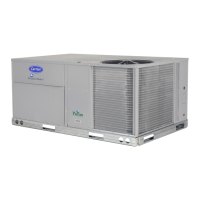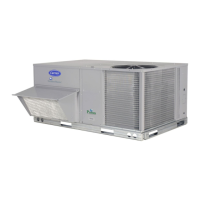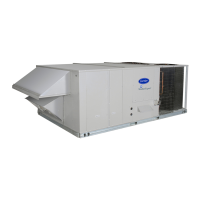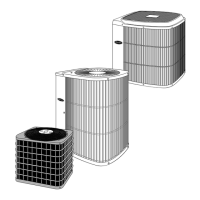38
SELECTION PROCEDURE (WITH 50TCQA07 EXAMPLE)
(Selection software by Carrier saves time by performing many of the steps below.)
I. Determine cooling and heating loads.
Given:
Mixed Air Drybulb 80_F(27_C)
Mixed Air Wetbulb 67_F(19_C)
Ambient Drybulb 95_F(35_C)
TC
Load
65.0 MBH
SHC
Load
46.0 MBH
HC
Load
45.0 MBH
Outdoor-Air Winter Design Temp 0_F(--18_C)
Indoor Air Winter Design Temp 70_F(21_C)
Vertical Supply Air 2100 CFM
External Static Pressure 0.66 in.wg
Electrical Characteristics 230--3--60
II. Make an initial guess at cooling tons.
Refrig. tons = TC
Load
/ 12 MBH per ton
Refrig. tons = 65.0 / 12 = 5.42 tons
In this case, start by looking at the 50TCQA07.
III. Look up the rooftop’s TC and SHC.
Table 11 shows that, at the application’s supply air
CFM, mixed air and ambient temperatures, the
50TCQA07 supplies:
TC
Load
= 69.0 MBH
SHC
Load
= 50.7 MBH.
IV. Calculate the building Latent Heat Load.
LC
Load
=TC
Load
-- S H C
Load
LC
Load
= 65.0 MBH -- 46.0 MBH = 19.0 MBH
V. Select electric heat.
Enter the Instantaneous and Integrated Heating Rat-
ings, Table 18 at 2100 cfm. At 70_F(21_C) return
indoor air and 0°F(--18_C) air entering outdoor coil,
the integrated heating capacity after interpolation, is
24,300 Btuh. (Select integrated heating capacity
value since deductions for outdoor-coil frost and de-
frosting have already been made. No correction is re-
quired.)
The required heating capacity is 45,000 Btuh. There-
fore, 20,700 Btuh (45,000 – 24,300) additional elec-
tric heat is required.
Determine additional electric heat capacity in kW.
20,700 Btuh
=6.1kWofheatrequired.
3413 Btuh/kW
Enter the Electric Heating Capacities table for
50TCQA07 at 208/230, 3--phase. The 6.5-kW heater
at 230V most closely satisfies the heating required.
6.5 kW x 3413 = 22,185 Btuh
Total unit heating capacity is 46,485 Btuh (22,185 +
24,300).
VI. Calculate RTU Latent Heat Capacity
LC = TC -- SHC
LC = 69.0 MBH -- 50.7 MBH = 18.3 MBH
VII. Compare RTU capacities to loads.
Compare the rooftop’s SHC and LC to the building’s
Sensible and Latent Heat Loads.
See Notes 1 and 2.
VIII.Select factory options (FIOP)
Local code requires an economizer for any unit with
TC larger than 65.0 MBH.
IX. Calculate the total static pressure.
External static pressure 0.66 in. wg
Sum of FIOP/Accessory static +0.14 in.
wg
Total Static Pressure 0.80 in. wg
X. Look up the Indoor Fan RPM & BHP.
Table 35 shows, at 2100 CFM & ESP= 0.8,
RPM = 1268 & BHP = 1.52
XI. Determine electrical requirements
Table 47 shows the MCA and MOCP of a
50TCQA07 (without convenience outlet) with 6.5
kW electric heater as:
MCA = 52.3 amps & MOCP = 60 amps
Min. Disconnect Size: FLA = 50 & LRA = 199.
Legend
BHP — Brake horsepower
FLA — Full load amps
HC — Heating Capacities
LC — Latent capacity
LRA — Lock rotor amp
MBH — (1,000) BTUH
MCA — Min. circuit ampacity
MOCP — Max. over---current protection
RPM — Revolutions per minute
RTU — Rooftop unit
SHC — Sensible heat capacity
THC — Total capacity
NOTES:
1. Selecting a unit with a SHC slightly lower than the
SHC
Load
is often better than oversizing. Slightly lower
SHC’s will help control indoor humidity, and prevent tem-
perature swings.
2. If the rooftop’s capacity meets the Sensible Heat Load,
butnottheLatentHeatLoad.
50TCQ

